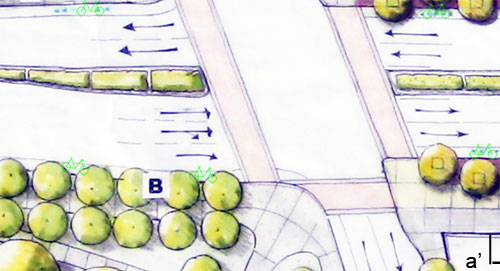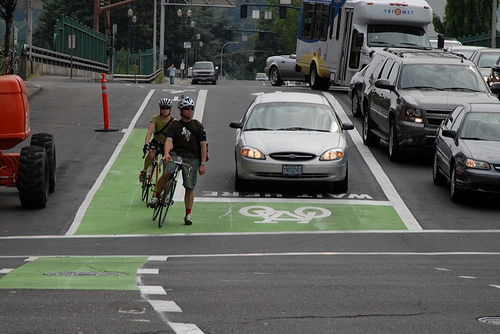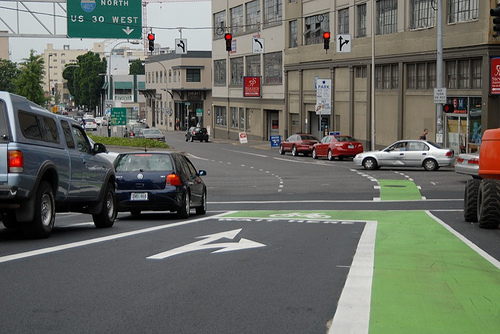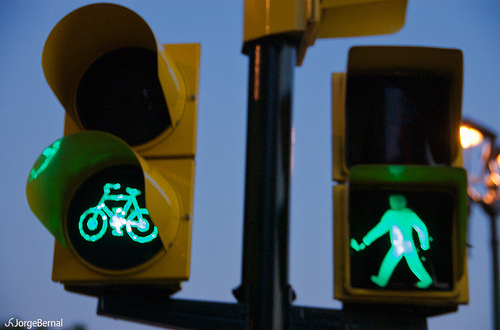
Something I did not touch on in my last post on the Wickeneden alternatives was the bike lanes.
The image above shows Point Street coming in from the left continuing across to Wickenden Street. South Water Street crosses from top to bottom, north is more or less up.
The plan is for the Point Street Bridge to have sharrows allow for bikes to share the travel lanes over the bridge. On the Wickenden side of the bridge, through the intersection there are bike lanes.
Bike traffic can either turn right onto South Water Street to go through India Point Park, or continue straight through the intersection to a “shared use” path which runs between South Main and Benefit, then between George M. Cohan Boulevard and the highway to the India Point Park Bridge (and through the park to the Washington Bridge and eventually the East Bay Bike Path).
Looking at the image above, you can see that the eastbound bike path sits to the right of a right turn lane and a lane that allows right turns and through traffic. So when the light turns green, bikes going straight will be in conflict with two-lanes of traffic turning right (pedestrians will be as well).
There is a traffic control device that can help with this, it is called the Bike Box.

Bike Box at West Burnside and 14th in Portland, OR. Photo (cc) BikePortland.org.

Bike Box at West Burnside and 14th in Portland, OR. Photo (cc) BikePortland.org.
The Bike Box creates a box at the intersection. On a red light, cars stop behind the box and bikes stack in it. When the light turns green, bikes have a head start through the intersection ahead of the right turning vehicles.
Alternately, the bike and pedestrian conflict on the right turn could be handled with a traffic signal for bikes.

Bike and pedestrian signals in Spain. Photo (cc) koke.
Creating an all red phase where bikes and pedestrians are allowed to cross will of course complicate traffic light timing. However, all modes should have safe efficient travel and some extra wait time for vehicles is a fair trade off for bike and pedestrian safety. Giving bikes a light that coincides with the pedestrian light means that bikes will have to be reminded to yeild to pedestrians when turning right across the crosswalk.
What do you think about the way bikes will be traversing this new intersection?
Alternatives
Wickenden Street Alternative 1 
Wickenden Street Alternative 2 
Wickenden Street Alternative 3 



Right-turns-on-red don’t work well with pedestrians and bikes, after all they were a creation of Los Angeles car culture 50 years ago. In New York City with its many pedestrians and bikes, right-turns-on-red are illegal unless posted, which is rare. Maybe an answer would be to use signals with red and green arrows for right turns. Signals could be timed or paused to allow bikes and pedestrians a head start before cars start making right turns.
Since most signals are now microprocessor controlled it isn’t all that complex to do the timing for what you suggest.
It seems almost like overkill. They should just make the bike lane go to the left of the right turn lane. That would mean the bike lane crosses over the entrance to the right turn lane but if you make it really obvious (nice bright lane, signage warning cars, etc.) and you aren’t biking like a moron there shouldn’t be a problem.
The other big problem with a busy intersection like that and bicyclists is that there are a lot of *terrible* cyclists in PVD, especially on the east side. Being a downtown Chicago biking veteran I can say that cyclists there understand how to navigate traffic much better. In PVD you get a lot of people who don’t signal, don’t stop in the right places at traffic lights, and generally aren’t paying attention. Providence is definitely a “heads up” place to ride and there are a lot of cyclists (I am not saying they are all Brown students but thats where it is the worst) who just aren’t alert.
Kind of like driving in Providence
Given that crossover point, it would actually be preferable to not even have a bike lane there. As I recall, if there is a bike lane, cyclists are required to use them. Using vehicular cycling techniques, just let cyclists select the lane they want.
As has already been discussed here, there was discussion about the I195 Ramp/Wickenden intersection on a recent Bike Providence post that suggested light timing alterations with dedicated pedestrian/cyclist crossing times seems the most reasonable. Given the expectation of family and path users coming through these intersections this is probably the best option.
As I recall, from last year, RIDOT was planning to make it a no right on red intersection at Point/S. Main. Is this still their plan?
Ordinarily, I’m a fan of the idea that bikes are just another mode of road user and should move with traffic and follow traffic control measures. The speed limit in the city is 25mph and functionally traffic often moves a lot slower, so bikes should be able to keep up and go with the flow.
In this area however, I do favor some sort of intervention for bikes. The traffic volumes are high here, the number of lanes makes bikes being able to flow more difficult. And this being a main route to the East Bay bike path, there will be many casual riders here, people not acclimated as much to road biking.
I can see moving the bike lane to the left of the right turn lane working, but there are two right turn lanes and the middle lane also allows traffic to go straight. So if you move the bike lane to between the right and middle lanes, you still have bikes going straight in conflict with cars turning right. If you move the bike lane to between the middle and left lanes, then the right turning bikes have to cross cars moving straight.
I think some sort of signal for bikes/pedestrians would be the best option here.
As for the issue with the Brown students. I don’t think that is a stereotype at all, I think it is true that Brown and RISD students are poor bike riders (not all of them, but as a group, they tend to be poor). This is of course because they come from all over the country. They are encouraged not to bring cars, so they decide to get bikes. For most of them, they’ve never ridden on the street and aren’t aware of the rules (some of them are probably just stupid though). It would help if the schools did some outreach in this area, helping the students realize what the rules of the road are.
Not all cyclists excel at it, and not all drivers are used to being around cyclists. That being said, it makes sense to make the process as idiot-proof and as safe as humanly possible. Large, brightly colored bike lanes do that. It reminds cars that there are other users on the road, and keeps less skilled cyclists in a contained area. Bike lanes are the best way to separate cyclists and cars and reduce collisions. Most normal commuters are not riding 25 mph – we have baggage and lousy bikes because our nice ones get stolen in Providence. We need bike lanes!!!!